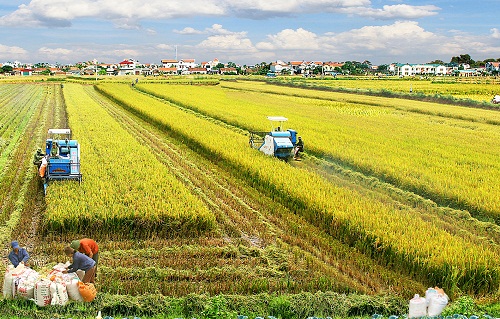Appropriate growth plan considered for 2018
The Ministry of Planning and Investment (MPI) has outlined three scenarios for economic growth in 2018, in preparation for the next year's socio-economic development plan with GDP growth expected to be at 6.4-6.8%.
 |
PM has said "All ministries, sectors, localities and corporations must continue to scrutinise again the set target and drastically strive to fulfill it." (source: NDO)
According to the Head of MPI’s Department for National Economic Issues Tran Quoc Phuong, the three scenarios for the 2018 development plan were developed by the MPI on the basis of the estimates made in 2017, forecasts for the global and domestic economy in 2018, and taking into account the objectives of the five-year, socio-economic, development plan during 2016-2020, as well as the direction given by the Prime Minister on the implementation of the socio-economic development plan for 2018, with expected GDP growth at 6.4-6.8%.
The MPI also set a forecast economic growth target of 6.7% for 2017, which is considered to be "achievable", and formally reported to the Government on three economic growth scenarios for 2018. In particular, in a low growth scenario, GDP is expected to grow by 6.4%; in an average scenario, the growth rate will stand at 6.5%; and in the high scenario, the growth rate is expected to be 6.81%.
The three scenarios have been developed but amidst the projection for 2018 and the following years, in which the mining sector may continue to decline which will affect the country's growth and while the current economic model cannot move right away, the MPI believes that in the aforementioned scenarios, the medium scenario is the most suitable option.
This proposal has also received supports from many cabinet members. It is likely that the 2018 socio-economic development plan will set GDP growth target of 6.5%, a reasonable growth rate.
In addition to setting growth targets for the coming year, the focus of socio-economic development in 2018 is consistently identified as "ensuring macroeconomic stability, controlling inflation and creating a stable foundation for economic development," Tran Quoc Phuong added.
Meanwhile, the 2018 plan also targets moving gradually towards the implementation of economic restructuring and deploying three strategic breakthroughs in order to create new growth engines, thereby re-impacting and creating macroeconomic stability on a higher scale and level.
In addition, it aims to continue promoting the growth of relevant sectors and branches, creating favourable conditions for economic development in the following years, and striving to achieve the five-year, socio-economic, development plan's objectives set for 2016-2020.
Although there are positive and optimistic signals for the economy in 2018, it cannot be denied that a number of difficulties and challenges are waiting ahead. One of the most visible challenges is the possibility of achieving a 6.7% growth target this year. If this target is not met, it will affect the setting of economic growth target for the coming year.
 |
Agriculture, one of the key sector of Vietnam's economy (source: The environment and life)
Therefore, during the government's monthly meeting for August 2017, the Prime Minister repeatedly emphasised that: "All ministries, sectors, localities and corporations must continue to scrutinise again the set target and drastically strive to fulfill it. Industry, agriculture and services, including tourism, should remain focused; if lagging behind for even one month, the 6.7% target may not be met.”
According to the MPI, the difficulties and challenges for 2018, besides the objective factors, are also issues related to the internal weaknesses of the economy, including the economic model being based mainly on cheap labour and at a low-tech level; land and natural resources are gradually depleting, while the efficiency of land use has not increased significantly; whilst domestic enterprises are still limited in terms of scale and operating capacity, leading to restrictions in competitiveness.
In addition, new difficulties may also arise, as the synergy for economic growth provided by oil, gas and coal, and Samsung's contribution and remittances are leveraged and unlikely to increase. This issue, in combination with a limited fiscal and monetary policy and difficulty in raising capital for development, will have a significant impact on the 2018 economic growth.
In this regard, Director of Central Institute for Economic Management Nguyen Dinh Cung said that the growth of the economy relies heavily on the development of the business sector, but the private sector still faces many difficulties.
According to statistics, only one third of private enterprises are profitable. If in next year the salary rate and a series of costs increase, they would affect the business efficiency of this sector; therefore, the number of profitable enterprises would reduce and thus affect economic growth.
It is necessary to reconsider the economic efficiency of the "steel fists" of the economy – State-owned corporations, at least to review the business performance of 30 SOEs. While assigning next year’s tasks for these units, it should not be in the direction of how many tonnes of oil or coal has been exploited, but how much profit and how much the profit rate is, which means focusing more on quality.
In addition, the proposal to increase the value added tax (VAT) at this time is also stirring social concerns. This issue should be thoroughly considered and calculated to come up with the most appropriate option.
Regarding the VAT increase, Tran Quoc Phuong said that the MPI, when reporting the issue to the Government, mentioned that the VAT increase in the time ahead should be thoroughly researched and include an impact assessment for State budget collection, as well as impact on the consumption of the entire population, especially those with low income, on production costs of enterprises, and on labour and employment./.
( VNF/NDO )
Most read

Thank-you Message of State Funeral Board, Family of General Secretary Nguyen Phu Trong







